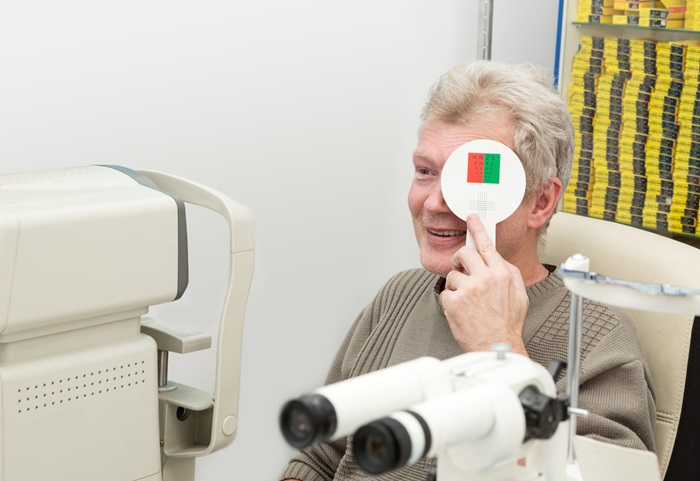What is Vision Therapy—and How Does it Help?

August 25, 2021
Sometimes, even small vision changes can cause difficulty with everyday activities.
However, many people who are living with visual deficits are not aware that help is available. Vision therapy may help improve quality of life for people who are living with conditions such as:
- Concussion
- Diabetes
- Eye trauma
- Glaucoma
- Macular degeneration
- Multiple sclerosis
- Stroke
- Traumatic brain injury
- Parkinson’s disease
What is vision therapy?
Vision therapy is a way to help maintain or improve visual skills, visual processing, visual endurance and interpreting of visual information. The goal of vision therapy is to make visual tasks easier, more efficient and more comfortable for adult and pediatric patients.
“Vision guides daily function, and vision therapy can help to improve quality of life,” says Kathryn Tuazon, MS, OTR/L.
What symptoms can vision therapy treat?
Vision therapy can address a variety of symptoms and functional complaints, including:
- Blurry vision
- Difficulty reading
- Difficulty tracking moving objects
- Double vision
- Eye fatigue
- Eye strain
- Light sensitivity
- Missing vision/visual field cuts
- Poor visual endurance
- Problems with peripheral vision
- Vision induced headache or dizziness
“The eyes function through fine muscles, which are among the most overused in the body,” explains Christine Greiss, D.O., a physical medicine and rehabilitation specialist and director of the Concussion Program at JFK Johnson Rehabilitation Institute. “Vision therapy can treat problems with these muscles, helping them to become stronger and work together properly.”
“If left untreated, these symptoms can not only impact daily functioning, but can also throw off a person’s balance and increase their risk of falls,” says Tuazon.
How does vision therapy work?
Vision therapy starts with a complete evaluation by a qualified occupational therapist. The evaluation will include an assessment of:
- Central/focal vision (which impacts your attention, focus and ability to process fine details)
- Eye range of motion
- Monocular and binocular vision (or how well your eyes work alone and together)
- Peripheral/ambient vision (which impacts movement, balance and interaction with your environment)
- Symptoms and triggers
- Visual perceptual and processing skills (or how your brain processes and interprets visual information)
- Visual tracking skills (or how well your eyes follow moving objects)
In addition, your therapist may screen for any visual deficits that may require further referral to other specialists such as a neuro-optometrist.
“Based on the results of your assessment, your occupational therapist will determine whether you need rehabilitative therapy to treat your condition or compensatory therapy to assist with function using adaptive aids, tools and environmental modifications,” shares Tuazon.
Some examples of rehabilitative treatments may include:
- Oculomotor exercises to improve range of motion, tracking and convergence skills which can be important for activities such as reading and computer use
- Peripheral awareness training for improved ability to interact with the environment without loss of balance or dizziness
- Visual perceptual activities such as puzzles and shape/pattern recognition or copying
Some examples of compensatory treatments may include education and practice with:
- Environmental adaptations/modifications to decrease fall risk or promote independence
- Low vision aides such as magnifying equipment and assistive technology
- Scanning techniques to compensate for visual field loss when at home or in the community
How can vision therapy help people with neurological conditions or injuries?
Neurological conditions such as multiple sclerosis, brain injury, stroke, concussion and Parkinson’s disease can affect eye movement and speed, eye alignment and the brain’s ability to process visual input.
“We can prescribe exercises to help the eyes regain strength and work together more efficiently,” comments Dr. Greiss. “We can also use specialized prism glasses that bend light, affecting how an image is processed through the eyes, which can help to improve symptoms.”
Athletes of all ages who sustain a concussion may benefit from vision therapy to treat eye strain and fatigue. Vision therapy can also help with eye teaming – or the ability of the eyes to work together – and visual endurance after a concussion.
How can vision therapy help people with ophthalmologic conditions?
An ophthalmologist typically treats diabetic retinopathy, glaucoma, eye trauma and macular degeneration, but vision therapy may help manage these conditions through adaptations that can improve quality of life.
“We take a trial-and-error approach to help patients find the adaptations that work best for them,” says Tuazon. “We can evaluate their house for safety hazards, increase contrast in different areas around the house, change the lighting, and train the patient on compensatory techniques to maximize their independence.”
What are the benefits of vision therapy?
Dr. Greiss and Tuazon both agree that vision therapy can significantly improve quality of life.
“Vision therapy is highly personalized to each patient’s symptoms, condition and environment,” says Tuazon. “We assess each patient’s circumstances and develop a plan to improve their condition.”
“Vision therapy is a newer modality, and many patients aren’t aware that it is available,” notes Dr. Greiss. “Your eyes are a big deal, and you can’t underestimate the quality-of-life benefits of improved vision.”
How do I know if vision therapy is right for me?
Patients will require a referral/prescription from a physician to start vision therapy. Additional evaluation by a vision rehabilitation specialist such as a neuro-optometrist prior to or soon after starting vision therapy may be beneficial for some to confirm diagnosis and maximize outcomes of treatment.
The material provided through HealthU is intended to be used as general information only and should not replace the advice of your physician. Always consult your physician for individual care.
Find a doctor near me
Causes and Signs of an Enlarged Thyroid

Learn about enlarged thyroid causes and signs. Dr. Shifrin explains risk factors and symptoms. Get your thyroid checked today for peace of mind.
The Numbers Behind Parkinson's Disease

Understand Parkinson's disease statistics. Learn key facts and figures. Access reliable information now.
Find a doctor near me

How to Identify Early Signs of Stroke
Recognize stroke symptoms? Learn early stroke signs from Dr. Pavuluri. Get timely medical attention to reduce disability risk.

Five Tips for a Healthier Workout
Three of our cardiologists share how to fit heart healthy exercise into even the busiest schedules.

Does COVID-19 Make You Lose Weight?
COVID-19 Weight Loss: Understand why illness impacts weight. Learn insights from Dr. Yotsuya, Raritan Bay Medical Center. Call 800-822-8905.

COVID Vaccine and Children: What to Know
Here's everything parents need to know about the COVID vaccine.
